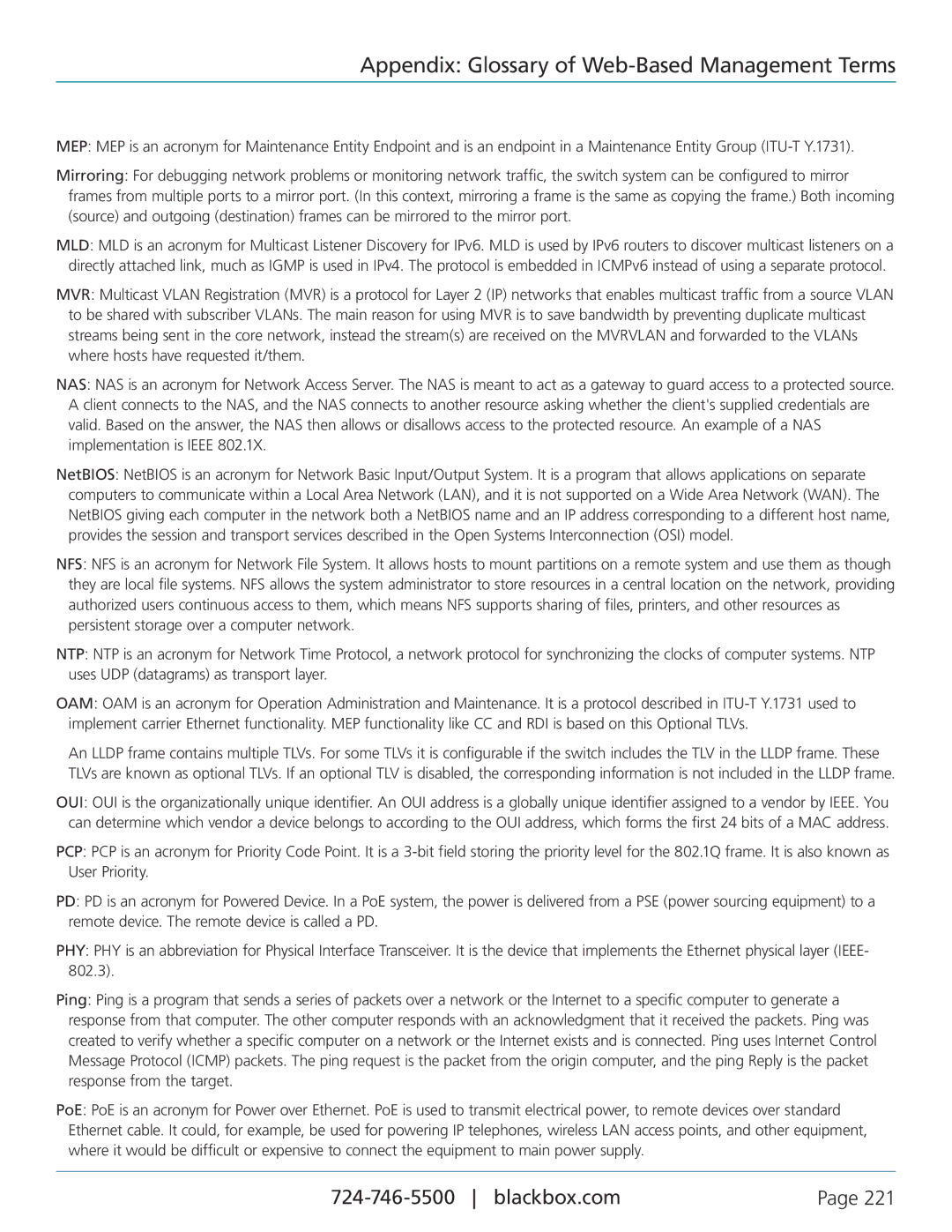
Appendix: Glossary of Web-Based Management Terms
MEP: MEP is an acronym for Maintenance Entity Endpoint and is an endpoint in a Maintenance Entity Group
Mirroring: For debugging network problems or monitoring network traffic, the switch system can be configured to mirror frames from multiple ports to a mirror port. (In this context, mirroring a frame is the same as copying the frame.) Both incoming (source) and outgoing (destination) frames can be mirrored to the mirror port.
MLD: MLD is an acronym for Multicast Listener Discovery for IPv6. MLD is used by IPv6 routers to discover multicast listeners on a directly attached link, much as IGMP is used in IPv4. The protocol is embedded in ICMPv6 instead of using a separate protocol.
MVR: Multicast VLAN Registration (MVR) is a protocol for Layer 2 (IP) networks that enables multicast traffic from a source VLAN to be shared with subscriber VLANs. The main reason for using MVR is to save bandwidth by preventing duplicate multicast streams being sent in the core network, instead the stream(s) are received on the MVRVLAN and forwarded to the VLANs where hosts have requested it/them.
NAS: NAS is an acronym for Network Access Server. The NAS is meant to act as a gateway to guard access to a protected source. A client connects to the NAS, and the NAS connects to another resource asking whether the client's supplied credentials are valid. Based on the answer, the NAS then allows or disallows access to the protected resource. An example of a NAS implementation is IEEE 802.1X.
NetBIOS: NetBIOS is an acronym for Network Basic Input/Output System. It is a program that allows applications on separate computers to communicate within a Local Area Network (LAN), and it is not supported on a Wide Area Network (WAN). The NetBIOS giving each computer in the network both a NetBIOS name and an IP address corresponding to a different host name, provides the session and transport services described in the Open Systems Interconnection (OSI) model.
NFS: NFS is an acronym for Network File System. It allows hosts to mount partitions on a remote system and use them as though they are local file systems. NFS allows the system administrator to store resources in a central location on the network, providing authorized users continuous access to them, which means NFS supports sharing of files, printers, and other resources as persistent storage over a computer network.
NTP: NTP is an acronym for Network Time Protocol, a network protocol for synchronizing the clocks of computer systems. NTP uses UDP (datagrams) as transport layer.
OAM: OAM is an acronym for Operation Administration and Maintenance. It is a protocol described in
An LLDP frame contains multiple TLVs. For some TLVs it is configurable if the switch includes the TLV in the LLDP frame. These TLVs are known as optional TLVs. If an optional TLV is disabled, the corresponding information is not included in the LLDP frame.
OUI: OUI is the organizationally unique identifier. An OUI address is a globally unique identifier assigned to a vendor by IEEE. You can determine which vendor a device belongs to according to the OUI address, which forms the first 24 bits of a MAC address.
PCP: PCP is an acronym for Priority Code Point. It is a
PD: PD is an acronym for Powered Device. In a PoE system, the power is delivered from a PSE (power sourcing equipment) to a remote device. The remote device is called a PD.
PHY: PHY is an abbreviation for Physical Interface Transceiver. It is the device that implements the Ethernet physical layer (IEEE- 802.3).
Ping: Ping is a program that sends a series of packets over a network or the Internet to a specific computer to generate a response from that computer. The other computer responds with an acknowledgment that it received the packets. Ping was created to verify whether a specific computer on a network or the Internet exists and is connected. Ping uses Internet Control Message Protocol (ICMP) packets. The ping request is the packet from the origin computer, and the ping Reply is the packet response from the target.
PoE: PoE is an acronym for Power over Ethernet. PoE is used to transmit electrical power, to remote devices over standard Ethernet cable. It could, for example, be used for powering IP telephones, wireless LAN access points, and other equipment, where it would be difficult or expensive to connect the equipment to main power supply.
Page 221 |
